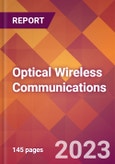Optical Wireless Communications (OWC) systems utilize the free-space optical links between the transmitter and the receiver to transmit data. OWC technology has an edge over F technology due to various factors. These factors include but are not limited to high energy efficiency, widely spread bandwidth, which is free from regulation, intrinsic security, and low economical costs. OWC technologies complement and enhance 5G wireless communications. By utilizing its huge available spectrum, light can deliver large amounts of data at fast speeds and with great security.
The report researches a wide spectrum of OWC-related items and concentrates on:
- VLC - Visible Light Communications
- LiFi - Light Fidelity
- OCC - Optical Camera Communications
- FSF - Free Space Fiber.
The report addresses Light Emitting Diodes (LEDs) technologies and markets. LEDs, in the near future, will be a dominant source of illumination; and used also as a transmitting device. The OWC LED-based channels promise to deliver high-speed data in offices, homes, and other environments with a high signal-to-noise ratio, and minimum infrastructure expenses.
The report analyzes the emerging OWC, particularly:
- Industry: The survey of more than 30 companies’ profiles shows the industry's strength and growth.
- Economics: The market specifics of VLC/LiFi/OCC and FSF are evaluated (2023-2027).
- Technologies: The detailed analysis of OWC technologies, their strengths, and weaknesses, including the latest developments is provided. The report addresses the specifics of each OWC technology and compares its functionalities.
- Standardization: An important prerequisite for the large-scale adoption of OWC technologies is the availability of standards. In this context, IEEE 802.15, IEEE 802.11, ITU-R as well as other organizations are working to standardize OWC technology. Multiple OWC standards are analyzed in this report to create a diverse picture of the industry directions.
- Applications: The report emphasizes that the spectrum of OWC applications is increasing each year to support such developments as Intelligent Transportation Systems, Localization, and others. Both indoor and outdoor users can appreciate OWC features in multiple instances when comparing them with RF transmission.
The report also surveys OWC-related patents. This report is important to a wide population of researches, and technical and sales staff involved in the developing of advanced Optical Wireless Communications systems. It is recommended for both service providers and vendors who are working with related technologies.
Table of Contents
Companies Mentioned
- CBL
- CableFree
- Casio
- Dailianxu Engineering Company
- FSF Industry
- Firefly
- Fraunhofer IPMS
- Global LiFI Tech
- Guilin
- Lightbee
- NEC
- Nakagawa Laboratories
- Nokia
- Oledcomm
- Outstanding Technology
- Plaintree
- PureVLC-PureLiFi
- Qualcomm
- Renesas
- SA Photonics (a CASI Company)
- Signify (Philips Lighting)
- Supreme Architecture
- Transcelestial
- VLNComm
- Zero1
- fSONA
Methodology
Considerable research was done using the Internet. Information from various Web sites was studied and analyzed; evaluation of publicly available marketing and technical publications was conducted.
Telephone conversations and interviews were held with industry analysts, technical experts and executives. In addition to these interviews and primary research, secondary sources were used to develop a more complete mosaic of the market landscape, including industry and trade publications, conferences and seminars.
The overriding objective throughout the work has been to provide valid and relevant information. This has led to a continual review and update of the information content.

LOADING...








